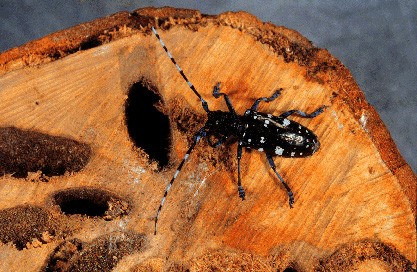Asian beetle, new in this country, threatens Brooklyn's shade trees
By Blaine Friedlander
A tree won't grow in Brooklyn.
Cornell University scientists have confirmed what they believe is the first known infestation of an Asian long-horned beetle, Anoplophora glabripennis, a large beetle that is attacking Brooklyn's horsechestnut and Norway maple tree population.
The Norway maple is the most planted shade tree throughout New York state.
This beady-eyed beetle, about 1-inch long, has coal-black wing covers sprinkled with startling white spots. The black and white antennae are long and impressive; the beetles are not harmful to humans. However, it was found devastating trees in the Greenpoint neighborhood of northern Brooklyn.
U.S. border entrances are jealously guarded to keep such pests from infiltrating this country. This beetle's anthology: Native to Japan, Korea and the southern sections of China, this is the first time this beetle has been seen outside of Asia, said E. Richard Hoebeke, Cornell senior extension associate and assistant curator in entomology.
It did not have a ticket to ride. "I don't know how it got here from Asia," Hoebeke said. "As if the trees in an urban environment are not traumatized enough as it is. This doesn't bode well for a tree that is under a lot of pressure to grow."
New York City's Department of Parks and Recreation sent samples of the beetles to Carolyn Klass, Cornell Cooperative Extension entomologist in Ithaca, N.Y., to determine the species. Klass had not seen the species before and showed it to her colleague, Hoebeke.
"I gasped when I saw it," Hoebeke said. "I knew this wasn't a species native to North America."
These beetles might prove to be the ultimate Brooklyn dodgers. Short of cutting down the maple and horsechestnut trees, there is little that can be done to curb the Greenpoint infestation, Hoebeke said, adding that there are no known natural predators.
For back-up species confirmation, Hoebeke sent specimens to the Carnegie Museum of Natural History, Pittsburgh, which verified the species on Tuesday. Hoebeke also has sent some of the Cornell samples to the Bishop Museum in Honolulu, Hawaii, which has one of the world's largest collection of Asian beetles -- the J. Lensley Gressitt collection. That confirmation is expected soon.
Three-quarter inch, circular holes in the Brooklyn trees led authorities to think pranksters were drilling them. But rather than human teen-agers causing the damage, adult beetles emerging from the heartwood center of the trees bore an exit hole through the outer bark. After beetle emergence, mating occurs, and eggs are laid in cavities in the bark, chewed out by females and covered with a cement secretion. Eggs hatch and young larvae bore into the inner bark, feed for awhile, and upon growing larger, bore into the tree's heartwood and pupate in the spring. The adult beetle then chews its way out, thus leaving the hole.
Larval feeding could hurt a tree's vascular system in an area where trees are under enormous pressure to grow, said Nina Bassuk, Cornell professor of floriculture and ornamental horticulture in Ithaca. "These trees are generally growing in places not made for trees, since there are sidewalks, houses, cement. The tree-lawns in Brooklyn are only 5 or 6 feet wide," Bassuk said. "The roots have little chance for water and the roots tend to be restricted. These insects might weaken the trees structually."
Bassuk took a survey of Brooklyn trees in 1990. She found that 27 percent of the 110,000 street trees in Brooklyn are Norway maples -- the trees this new beetle attacks most often.
"I think this could be devastating for the city," Bassuk said. "After all, the Norway maple is the most widely planted shade tree in New York State."
Get Cornell news delivered right to your inbox.
Subscribe